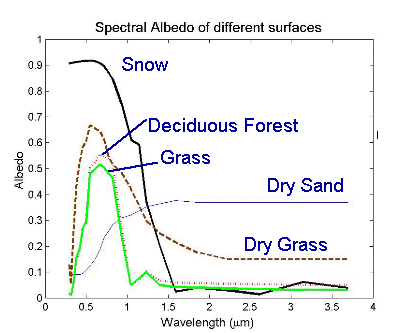 |
 |
 |
 |
|
Lesson 3: Surface Radiative PropertiesRemote Sensing the SurfaceIn remote sensing the surface of the Earth from a satellite, we select spectral regions, or channels, in which the atmosphere is transparent. These are called atmospheric windows. In the solar spectrum, or the shortwave, very little absorption occurs in the visible region; however, Rayleigh scattering is large. Rayleigh scattering is well understood and can be handled via modeling as described in the previous chapter. There are also windows in the near-infrared spectral regions where Rayleigh scattering is smaller.
The surface albedo depends on the wavelength of the incident radiation. Figure 6 is an example of spectral reflection of various surfaces. Snow is very reflective at visible wavelengths (.4 to .7 mm) and less reflective an the near-infrared wavelengths. Plants have higher reflectances in the near-infrared than in the visible. Photosynthesis is effective at absorbing visible energy. When plants dry out, their chlorophyll content decreases and the reflectance at visible wavelength increases. The figure below show typical values of spectral albedo as a function of surface type.  Analysis of the spectral reflectance of different surfaces generally shows a distinct difference between the visible and near IR regions. Observations in both the visible (such as 0.58- 0.68mm) and near-infrared (such as 0.725-1.1 mm) are useful for monitoring surface conditions. Vegetation regions generally have reflectances in the near-infrared (NIR) that range from 20-40%, while visible reflectances generally range from 5-15%. Soils also have a higher reflectivity in the NIR than in the visible while the opposite is true for snow.
|